The Skinny on Battery Backup Sump Pumps

Much has been written about battery backup sump pumps in the Frankfort, New Lenox and Mokena areas in the last several years. Many of the articles focus on a certain type or manufacturer that is being promoted in the market place. The problem I see with this type of article is that it is primarily designed to “sell” a certain type of battery back up system. That in itself creates a problem!
One Size Battery Backup Fits All?
Selling one type of battery back up system as a “One Size Fits All” type of solution is a guaranteed set up for a future nightmare. I have seen and replaced many “Big Box” store systems that were sold by an enthusiastic, albeit, uninformed employee of these types of stores. They only know what has been taught to them by the store that is marketing and selling a system determined by a certain price point. Think about that for a minute….
The store determines that they want to “sell” a battery back up system for $ 500.00. They then work backward so to speak and look for a system that they can mark up the standard retail 40 to 50%. Little or no thought is put into the technical aspects of the product they are going to sell. The typical big corporate mentality goes something like this: Cost + mark up x number of units = profit. And that is where the thought process ends.
New Lenox/Frankfort/Mokena Backup Sump Pump Needs
If you live in the New Lenox, Frankfort or Mokena area you may have, dependent upon which section of town you live in, experienced flooding due to sump pump failure or an extremely high influx of water into your sump basin during heavy rains.

How many times have you wished for the snow to melt?
I have lived in this area for more than 30 years and learned very quickly in my own home the woes of our rural drainage issues. My home’s sump pump used to run every 90 seconds regardless of the season or temperature outside. That’s right, EVERY 90 SECONDS! Drought, freezing temperatures and time of year had no impact on this cycle UNLESS it rained! Then it was “Game On” with the amount of water entering the sump pump basin exponentially increasing directly corresponding to the amount of rainfall.
Research on Sump Pumps
My basement flooded the day after I purchased my home some 30 plus years ago. As a plumber I found this to be completely unacceptable. What kind of plumber am I, if I couldn’t even keep my own basement from flooding? Kind of a pride thing I guess in retrospect…
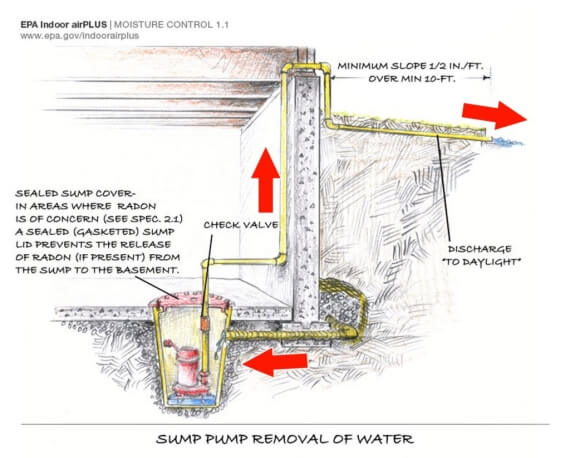
I began to research sump pumps and how they work. I learned about “head” or the amount of height that the pump must lift the water to get it out of your house. If you have an 8’ basement height one would think that a pump with an 8’ head would be sufficient. NOT SO! The sump pump basin sits at least another 18” below the floor, so the pumping capacity for head or lift has to be over 9.5 feet.
The Size of the Pump Matters
So, what happens when an 8’ head or lift pump is installed in your 9.5’ basement? Well, if you refer to the manufacturers pump curve charts you will find that the gallons per minute that the pump will take out of your home will be reduced by as much as 40%! So if your sump pump is designed to pump 60 gallons per hour at an 8’ head, raising the lift to 9.5 feet will cause the pump to only be able to remove 36 gallons per hour. This may be the difference between your basement flooding because the sump pump can’t keep up with the incoming water and not flooding.
In the worst case scenario, the sump pump may not even be able to “lift” the water out of the sump basin! Many of the more economical (cheap) sump pumps sold by the Big Box stores fit into the latter category, resulting in an ongoing and aggravating issue even after you think the problem is resolved.
Horsepower Varies
I also learned that all sump pumps are not created equal! Sump pumps are sold and rated by the horsepower that the electric motor generates. The smallest on the market is a ¼ horsepower and they continue upwards from that point. A ¼ hp. The sump pump will only suffice in the lightest of conditions with a very small amount of lift or head required. A crawlspace that is 3 to 4 feet deep that only sees water during heavy rain would be an application for this type of pump, but only if the water flows into the sump pump basin is light.
Variations in the Construction of the Pump
The other main differences in sump pumps are the switching or on/off mechanism and the type of construction of the pump. Switches come in several different types, float style, that triggers a mechanical switch by the float raising with the water level in the sump basin until it pushes an actuator arm upwards activating the water while conversely pulling the trip lever down as it pumps the water out of the sump basin. A pressure type of switch that sits submerged in the water. As the water level rises above the switch, the pressure that the water creates on top of the switch causes the switch to turn the sump pump on. Conversely, as the water is pumped out, the switch turns off as the pressure of the spring inside the switch becomes greater than the water pressure and shuts the sump pump off. Then there are classes of motors. Thermostatically protected, meaning oil filled motors that will shut down and cool off rather than burning out when they get hot and non protected that depends on the motor being submerged in the water in the sump pump basin to keep them cool. When the sump pump experiences a constant run event these sump pumps burn out very quickly.
Death of a Sump Pump
So what causes your sump pump to quit? In a word, “cycles”. Cycles are the word used to determine how many times the sump pump turns on and off in a given time frame. The time frame may vary depending upon if and when the sump pump basin receives additional water due to rainfall. Every sump pump made has some sort of switch to activate it. Every switch made has a “cycle life” or number of times it will turn on and off before it fails. Better than 90% of the sump pumps we replace are out due to switch failure. That is a powerful statement! 90%! The motor may still be good, but the switch has failed causing the sump pump not to run. You may ask, “Why don’t you as a contractor just change the switch?” The answer to that is past experience. Years and years ago we used to offer switch replacement as an option to our clients. The cost of labor to remove the pump, tear it down and replace the switch was better than 60% of the cost of a new pump. Numerous times we would be called back due to the pump failing a second time in short order only to find that the motor was now burnt up. Once in a while we experienced water getting inside the switch housing causing the sump pump to short out once it had been taken apart. Imagine if you paid $200 to have the switch replaced on your sump pump only to have to purchase a new pump a week later! We decided not to offer this service after we put ourselves in our clients’ shoes and realized it was not the type of service our clients deserved.
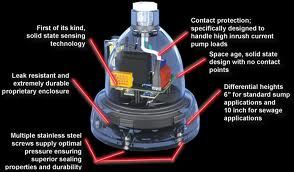
Sump Pump Basins
The other issue we have encountered in the New Lenox/Frankfort/Mokena area is the existence of “Crock” sump pump basins. Houses that were built in the late ’70s and early ’80s were built with the standard 4” corrugated plastic pipe with perforations, but the sump basins were made of Vitrified Clay pipe. (VCP) It is distinguishable by it’s orange to “clay” coloring. The minimum standard dimensions of a sump basin today are 18” in diameter and 24” in depth. It is also to have a sealed bottom and lid. The old clay basins, such as the one in my own home, was 18” in diameter, but had no bottom other than the mud that it was dug into. This facilitated the need for some sort of brick or block placed in the bottom of the sump basin to raise the sump pump above the mud bottom so it would not become blocked. Definition: BAD Not only is the chance of the pump becoming blocked with mud and stone great, the placement of the bricks or block in the bottom of the sump basin raises the sump pump to the point that the sump pump would not turn on until the drain tile around the perimeter of the house was full, and in my own case, the water was 4” above the drain tile. When the pump finally turns on, the massive inrush of water into the sump basin will cause the sump pump to cycle numerous times in short order. Remember…what kills the sump pump….cycles.
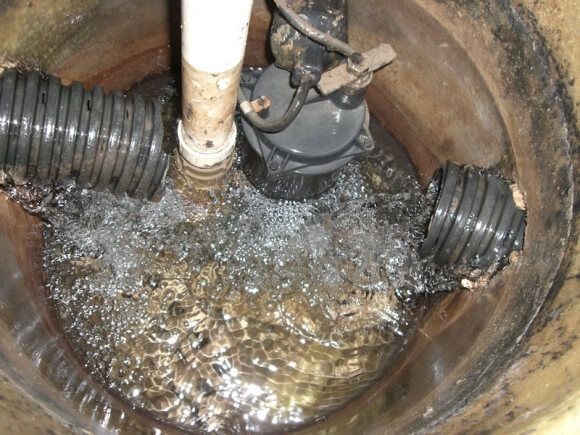

Putting Your Sump Pump on Bricks Is an Old Trick
The secondary issue with these sump basins is that because they are so shallow, many times the drain tile that keeps the water away from the footings of your home is partially full or at times, completely full of water. This is a bad scenario as the building footings and even the basement concrete floor are subjected to the water pressure from beneath at times causing cracking in the basement floor and at worst footing and foundation wall cracking subjecting your home to possible structural damage.
In the case of a sump pump failure, think about this…. How much time would you have if your pump quit working if the drain tile is already full of water and there is only, say, 2 to 4” of sump basin left to fill up? How long do you have before the sump basin overflows and begins to flood the basement? Compare that to a properly sized and installed sump basin that has 12” of space to fill below the drain tile AND the drain tile itself, THEN the 2 to 4” before it overflows into the basement. Is there a difference in time? Enough to get a new pump installed? Many years ago it was a prevalent homeowner trick to put bricks under your sump pump. There are still a few hardcore clients that won’t let us lower them. I am here to tell you that any perceived advantage is far outweighed by the numbers of engineering!
Discharge Piping
So, the sump pump pumps and the sump basin collects. How do I get rid of the water?
Discharge piping! This is the pipe that goes up and out of your sump basin. More importantly, than the pipe is; Where Does IT Send The Water To? If it dumps the water right outside the wall, I can guarantee a large portion of it is sinking right back down along the wall, being picked up by the drain tile and sent right back to the sump basin to be pumped right back out. The soil around the foundation of your home is the most porous soil on your property. It was all dug up and removed to put in your foundation.
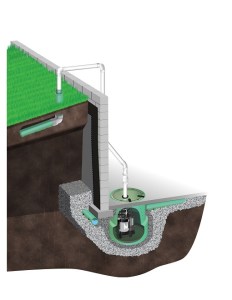
The dirt was then pushed back in the space between the undisturbed earth and your basement walls. This makes the ground around your basement a giant sponge! Water readily percolates into this disturbed earth many more times faster than undisturbed ground making it THE WORST place to discharge your sump pump water. To remedy this problem, an underground discharge line should be installed to get the water as far as possible from your foundation. They can run to natural drainage swales or end in a bubbler that pops up when the sump pump runs but drops down when it’s off so you can mow over it. The issue with a flat area bubbler is that the area will remain soggy for days after heavy rain so mowing may be an issue until it dries out.
NEVER make a solid connection between the sump pump discharge pipe and the underground piping! During the freezing weather, the line will freeze outside and leave your sump pump nowhere to push the water. This will result in the pump running like mad but not removing any water! We see it quite frequently! Always leave an open connection between the sump pump discharge and the underground drainage pipe. This will allow the pump to continue to run if the underground line freezes. Yes, you will experience some re-cycling of the discharge water, but it is better than flooding your basement!
The Perfect Storm (Buster)
So now that you’ve learned about all the components of the sump basin, sump pump and discharge lines, what can you do to help and protect yourself against basement flooding?
That question is kind of like the Big Box stores selling a “one size fits all” sump pump. Every home is different. Each of them has their own characteristics due to the ground they were built on, the ability of the soil to percolate rainwater back into the soil, the amount the soil is capable of percolating and if in my case in New Lenox, as is so common in Frankfort and Mokena, that my house was built on old farm field ground.
This doesn’t sound bad until you realize that farmers in the New Lenox, Frankfort, and Mokena area were quite adept at resolving field flooding issues through the use of subsoil drainage pipes. Many of these farms had vast networks of underground drain tile that eventually led to a main creek or river in the area. These drainage systems kept the farm fields from flooding and killing crops or making them implantable. Enter “The Builder”!
He buys the farmers property to build his subdivision. He has no clue there is this subterranean labyrinth of piping below his feet. He digs the foundation for your home and cuts through one of the pipes. If he sees it and there is no water coming out, he shrugs his shoulders and says, “Wonder what that’s doing out here?”. If there is water coming through it, he digs it back away from where your basement is going to go and pours concrete over it to stop the flow and says “ Wonder what that is doing out here?”
Your house is finished and you move in. Two days later your basement floods as the entire old farm field drain into your sump pump basin through the old farm tile! Doesn’t sound feasible? It’s EXACTLY what the problem was in my own home! But guess what? When they dug some other foundation, that pipe quit discharging water…at my home, BUT, some other poor guy wound up with it dumping into his! In my subdivision, once the building was completed, what we noticed was that we ALL had lots of water inflow when it rained. Some of us worse than others, but we all had it. Eventually, I figured out that we had just cut the farmer’s drainage system up into smaller pieces and that everyone who had a basement was draining his or her own little piece of the old farm field. This IS the case in much of the area around Frankfort, New Lenox, and Mokena!
Solutions to the Problem
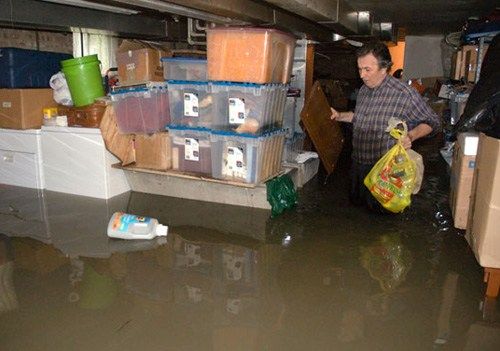
As I stated several times above, there is NO one size fits all solution. Each and every home is different. It really takes a trained eye and a lot of experience in the Frankfort/New Lenox/Mokena area to devise a solution that will truly resolve the sump pump issue. What we have discovered through many years of working on the problem, beyond the problems described above, is that there are unique ways to overcome the flooded basement issue!
Most importantly reduce the “cycles” of the pump. If you reduce the cycles, the pump lives longer. Correct basin sizing, proper pump sizing and number, and ensuring the discharged water is properly conveyed away from the house are key components. Each home is unique, but all of them can be resolved or rectified!
Battery Back Up Sump Pumps
There are so many battery back up sump pump systems offered on the market today that it has become beyond confusing! Every Big Box Store has the soup Dejour that they offer. I can tell you that the “soup Dejour is rotten. In the past twenty years, I have taken more out than I can keep track of. Don’t waste your time and money! The Basement Watchdog don’t bark! Trust me! The Water Powered back up system has cost a few of my clients as much as $5000.00 before they discovered the valve stuck open causing the system to dump water literally into the ditch outside 24/7 from their home water service. In this age of technology, the battery back up system has advanced light years. As with our Smart Phones and computers, they are capable of things today that we could only dream of several years ago. This smart technology, coupled with energy efficient pumps and controllers has brought the battery back up sump pump system to the forefront of technology. From duplex alternating pumps to sealed gel battery technology and Apps that notify you on your Smartphone, there are solutions and options for just about every circumstance and condition.
Let Expert Help!
Why not let us help you? With over 30 years experience in the Frankfort/New Lenox/Mokena area, no one understands the sump pump and battery back sump pump industry like we do! For an appointment today call 815-402-3856 or make your appointment for an evaluation of your needs at www.expertplumbers.com
Request Your Expert Plumbing Service Today

